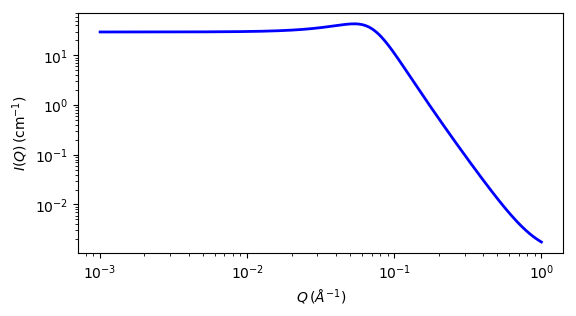teubner_strey
Teubner-Strey model of microemulsions
| Parameter | Description | Units | Default value |
|---|---|---|---|
| scale | Scale factor or Volume fraction | None | 1 |
| background | Source background | cm-1 | 0.001 |
| volfraction_a | Volume fraction of phase a | None | 0.5 |
| sld_a | SLD of phase a | 10-6Å-2 | 0.3 |
| sld_b | SLD of phase b | 10-6Å-2 | 6.3 |
| d | Domain size (periodicity) | Å | 100 |
| xi | Correlation length | Å | 30 |
The returned value is scaled to units of cm-1 sr-1, absolute scale.
Definition
This model calculates the scattered intensity of a two-component system using the Teubner-Strey model. Unlike dab this function generates a peak. A two-phase material can be characterised by two length scales - a correlation length and a domain size (periodicity).
The original paper by Teubner and Strey defined the function as:
where the parameters a2, c1 and c2 are defined in terms of the periodicity, d, and correlation length ξ as:
and thus, the periodicity, d is given by
and the correlation length, ξ, is given by
Here the model is parameterised in terms of d and ξ and with an explicit volume fraction for one phase, ϕa, and contrast, δρ2=(ρa−ρb)2 :
where 8πϕa(1−ϕa)(Δρ)2c2/ξ is the constant of proportionality from the first equation above.
In the case of a microemulsion, a2>0, c1<0, and c2>0.
For 2D data, scattering intensity is calculated in the same way as 1D, where the q vector is defined as

Fig. 119 1D plot corresponding to the default parameters of the model.
Source
References
- M Teubner, R Strey, J. Chem. Phys., 87 (1987) 3195
- K V Schubert, R Strey, S R Kline and E W Kaler, J. Chem. Phys., 101 (1994) 5343
- H Endo, M Mihailescu, M. Monkenbusch, J Allgaier, G Gompper, D Richter, B Jakobs, T Sottmann, R Strey, and I Grillo, J. Chem. Phys., 115 (2001), 580
Authorship and Verification
- Author:
- Last Modified by:
- Last Reviewed by: